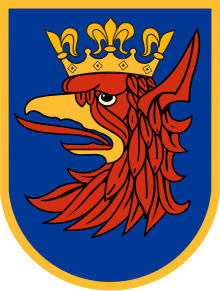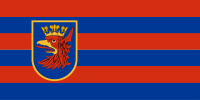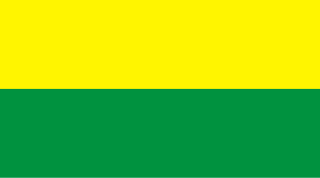
The Zielona Góra Voivodeship was a voivodeship (province) of the Polish People's Republic from 1975 to 1989, and the Third Republic of Poland from 1989 to 1998. Its capital was Zielona Góra, and it was centered on the southern Lubusz Land, in west-centre part of the county. It was established on 1 June 1975, from the part of the Zielona Góra Voivodeship, and existed until 31 December 1998, when it was incorporated into then-established Lubusz and Greater Poland Voivodeships.
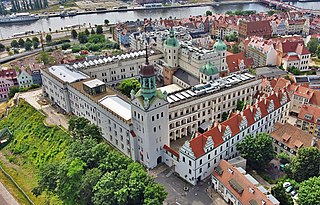
Śródmieście is one of four districts of the city of Szczecin, Poland, situated in central part of the city. In 2022, it had the population of 104 294 people, and an area of 45.9 km².

The coat of arms of Poznań consists of white city walls with three towers. On the left (heraldic) tower stands Saint Peter with a key and on the heraldic right one stands Saint Paul with a sword. In the gate there are two golden crossed keys with a cross above. Over the middle tower, which contains a single window and is topped by a battlement, there is a gothic shield with a white eagle in crown. On the sides of the two saints there are golden crescents and stars. All of those elements are on a blue field. Over the shield there is golden crown. Author of modern version of coat of arms is Jerzy Bąk.

Wirek is a district in the centre of Ruda Śląska, Silesian Voivodeship, southern Poland. In 2006 it had an area of 5.9 km2 and was inhabited by 20,595 people. On January 12, 2006 a part of it was split off to form a new district, Czarny Las.

Dziwnówek is a village in the administrative district of Gmina Dziwnów, within Kamień County, West Pomeranian Voivodeship, in north-western Poland. It lies approximately 4 kilometres (2 mi) north-east of Dziwnów, 8 km (5 mi) north of Kamień Pomorski, and 70 km (43 mi) north of the regional capital Szczecin.
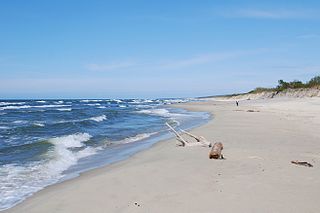
Nowa Karczma is a neighborhood of Krynica Morska on the Vistula Spit in northern Poland, located in the eastern part of the town.

Droga krajowa nr 98 was a route belonging to Polish national roads network.

The coat of arms of the city of Gdańsk, in its current form, dates back to 1410 and Banderia Prutenorum. The coat of arms is very similar to the flag of Gdańsk. It depicts two silver crosses on a red shield above each other, above which hovers a golden crown. The greater arms also has two lions as supporters and Gdańsk motto.

The flag of Poznań is a rectangular piece of white material with the coat of arms of the city placed in the middle. It was adopted in 1997.

The Lublin coat of arms is one of the city symbols of Lublin, Poland. The coat of arms was established by the Lublin City Council on 8 July 2004.

The flag is the symbol of the city of Szczecin in West Pomeranian Voivodeship, Poland.
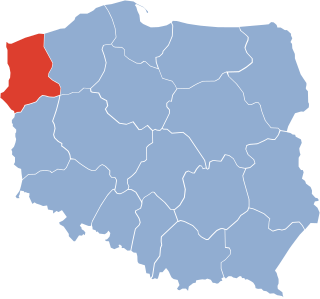
The Szczecin Voivodeship was a voivodeship (province) with capital in Szczecin, that was centered on the Farther Pomerania. It existed from 1946 to 1975. Until 19 February 1947 it was under the administration of Provisional Government of National Unity, which then was replaced by the Polish People's Republic. It was established on 28 June 1946, when it was formed from the territory of the District of the Western Pomerania, and parts of the Gdańsk, and Pomeranian Voivodeships. On 6 July 1950, its eastern half was incorporated into then-established Koszalin Voivodeship, and the voivodeship ceased to exist on 31 May 1975, when it was replaced by then-established Szczecin and Gorzów Voivodeships.
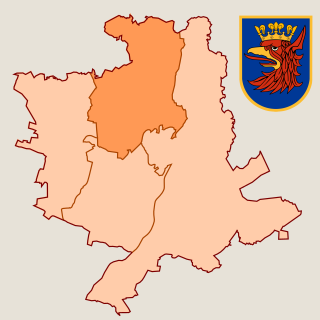
Nad Odrą was a district of the city of Szczecin, Poland, that functioned from 1954 to 1976.

Dąbie was a district of the city of Szczecin, Poland, that functioned from 1954 to 1976.

Pogodno was a district of the city of Szczecin, Poland, that functioned from 1954 to 1976.

Śródmieście was a district of the city of Szczecin, Poland, that functioned from 1954 to 1976.
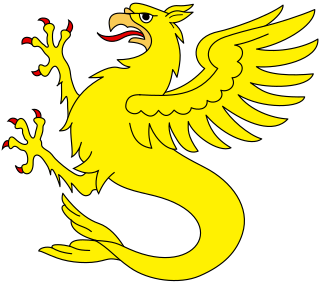
The sea-griffin is a heraldic charge in form of a creature with the upper-body of a griffin and the lower-half of a fish.

National road 68 is a main road of accelerated traffic belonging to the Polish national road network. The length of the route is 11.4 kilometres (7.1 mi), of which 5.197 kilometres (3.229 mi) is maintained by General Directorate for National Roads and Highways. The highway connects the Kukuryki border crossing on Belarus–Poland border with national road 2 in Wólka Dobryńska. It runs entirely in Lublin Voivodeship, in Biała County. According to signage, national road 68 is a component of European highway E30.

The coat of arms of the town of Białogard, Poland, depicts a red griffin standing on its back legs, above the blue horizontal wavy line. The current coat of arms was established in 2004.

National road 96 is a main road of accelerated traffic, belonging to Polish national roads network, with length of 1.5 kilometres (0.93 mi) and located in Toruń County. It connects motorway A1 with national road 15. With its length, the route is the shortest one of all national roads in Poland.
